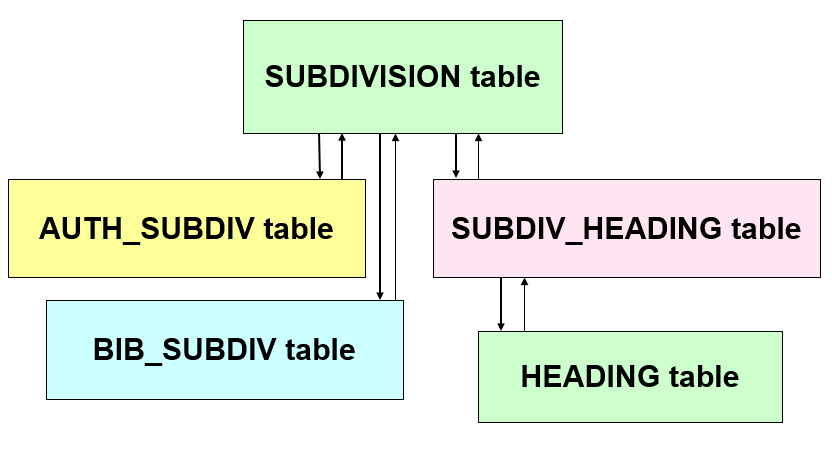Voyager tables that contain data relating to information extracted from authority and bibliographic records
- Product: Voyager
- Relevant for Installation Type: Multi-Tenant Direct, Dedicated-Direct, Local, TotalCare
Question
What are the tables that contain data relating to information extracted from authority and bibliographic records?
Answer
Seven Voyager tables contain data relating to information extracted from authority and bibliographic records. These seven tables form two groups: one group for main headings, one group for subject subdivisions.
In each group, one table serves as the point of entry; additional tables support this primary table. Ancillary tables (e.g., INDEX_TYPE, HEADING_TYPE) explain the coded information in these two groups of tables. One additional set of tables (not included here) describes changed headings.
Tables for Main Headings
- HEADING table
- AUTH_HEADING table
- BIB_HEADING table
The HEADING table is the principal entry point for queries of Voyager relating to authority-controlled main headings. Each row in this table describes one unique heading found somewhere in the bibliographic and/or authority records in a Voyager database.
The HEADING table contains the normalized form of each main heading, and some other information. The cataloging client uses this table when an operator performs a staff subject heading search, staff title heading search, staff name heading search or staff name/title heading search. There is one entry in this table for each different heading in the Voyager database. (For example, there is one row in this table for William Shakespeare as author, no matter how many bibliographic records with Shakespeare as main entry appear in the database.) The other two tables are dependent on the HEADING table. The AUTH_HEADING table lists each authority record in which a given heading appears. The BIB_HEADING table lists each bibliographic record in which a given heading appears. A Voyager-assigned control number links the HEADING table to the other two tables. Using these three tables, a program can derive a list of the authority records and/or bibliographic records that contain a given heading.

Tables for Subdivisions
- SUBDIVISION table
- AUTH_SUBDIVISION table
- BIB_SUBDIVISION table
- HEADING_SUBDIVISION table
The SUBDIVISION table contains the normalized form of each subject subdivision, and some other information. The cataloging client uses this table as the starting point when an operator requests a staff subject subdivision search. There is one entry in this table for each different subdivision in the Voyager database. (For example, there is one entry in this table for the form subdivision ‘Bibliography’ no matter how often that subdivision appears in bibliographic and authority records.) The next two tables are dependent on the SUBDIVISION table. The AUTH_SUBDIVISION table lists each subdivision authority record in which a given subdivision appears in a 18X, 48X or 58X field. The BIB_SUBDIVISION table lists each bibliographic record in which a given subdivision appears. A Voyager-assigned control number links the SUBDIVISION table to the other two tables. Using these three tables, a program is able to derive a list of the authority records and/or bibliographic records that contain a given subdivision.
The control number for a subdivision also links the SUBDIVISION table to the HEADING_SUBDIVISION table. This table matches the control number assigned a subdivision to the control number for each heading that contains the subdivision. Using the SUBDIVISION and SUBDIVISION_HEADING tables and then using the heading control number found in the SUBDIVISION_HEADING table as entry into the HEADING, AUTH_HEADING and/or BIB_HEADING tables, a program can derive a list of the headings in bibliographic and authority records that contain a given subdivision, and find the bibliographic and authority records themselves.

Additional Information
See also the Voyager Class Diagrams and Data Dictionaries.
- Article last edited: 16-Apr-2021

